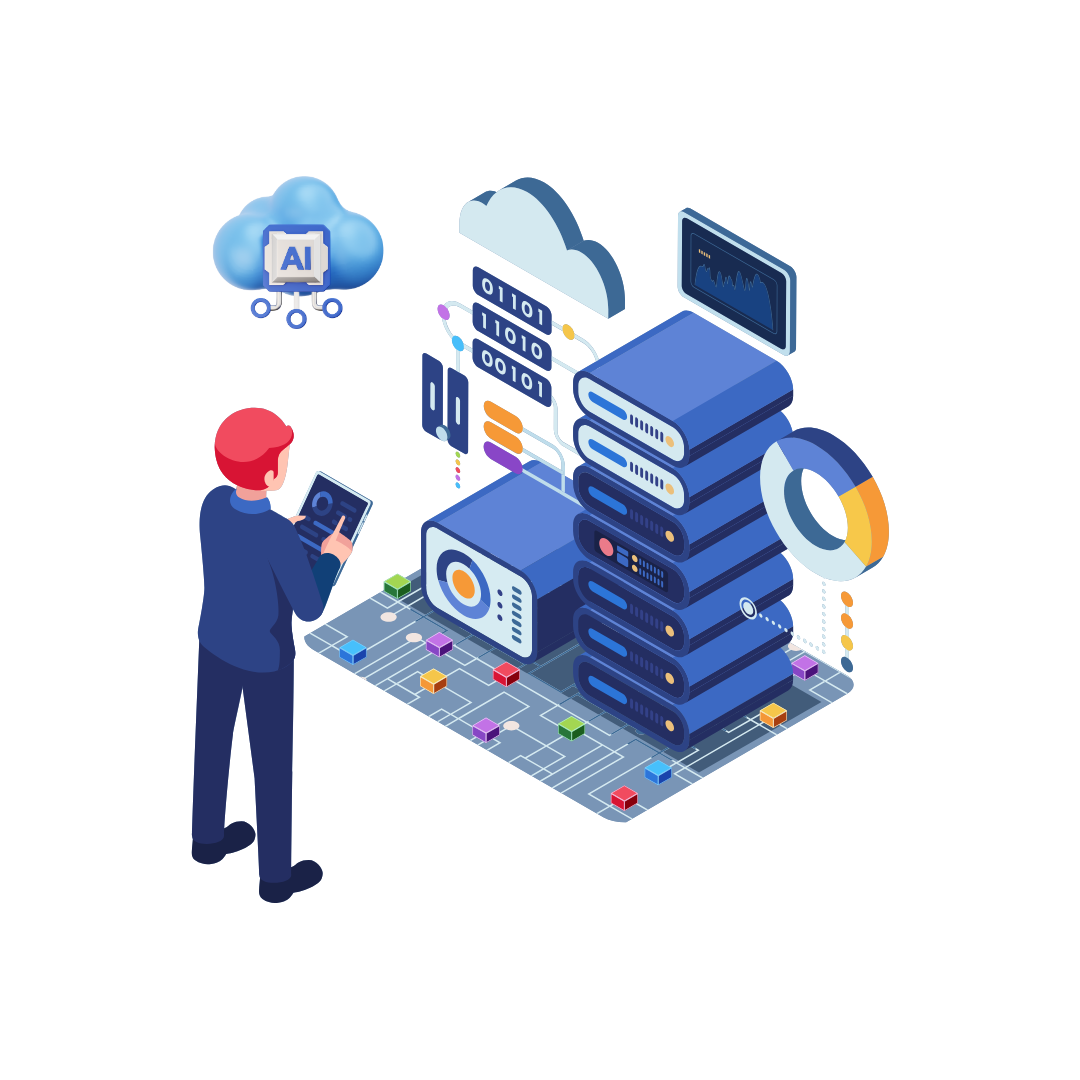Introduction
Electronic Data Interchange (EDI) and Artificial Intelligence (AI) are ushering in a new era of efficiency and innovation. This powerful combination is transforming how organizations handle data exchange, streamline operations, and make strategic decisions
The business world has long recognized the value of EDI in standardizing and automating data exchange between trading partners. This technology has been a cornerstone of B2B communication, enabling seamless transactions and reducing manual errors. However, as businesses face increasing demands for speed, accuracy, and flexibility, traditional EDI systems are evolving to meet these challenges.
Enter AI, a game-changing force elevating EDI capabilities to new heights. By infusing intelligence into data exchange processes, AI is helping businesses unlock unprecedented levels of efficiency, insights, and adaptability. This synergy between EDI and AI is not just an incremental improvement; it’s a paradigm shift in how organizations manage their information flows and business relationships
Key Takeaways
- AI enhances EDI capabilities, making systems more flexible, intelligent, and capable of handling complex data processing tasks.
- The benefits of AI-EDI integration span improved data accuracy, process efficiency, advanced analytics, and decision-making capabilities.
- Implementing AI-powered EDI requires careful planning, clear objectives, and a commitment to ongoing optimization and learning.
- While challenges exist, such as data quality issues and complex integration, they can be overcome with the right strategies and best practices.
- The future of AI-EDI holds exciting possibilities, from autonomous systems and blockchain integration to applications in quantum computing and augmented reality.
- Real-world case studies demonstrate the significant impact AI-EDI can have on operational efficiency, customer satisfaction, and bottom-line results across diverse industries.
What is Business Process Automation?
Business Process Automation (BPA) is the use of technology to streamline and optimize repetitive, manual business tasks. It helps organizations improve efficiency, reduce human error, and enhance productivity by automating processes such as order processing, invoicing, data entry, and supply chain management. BPA leverages various technologies, including Electronic Data Interchange (EDI), Artificial Intelligence (AI), Robotic Process Automation (RPA), and Workflow Automation, to create seamless, error-free business operations.

The Evolution of EDI: From Traditional to AI-Powered

Electronic Data Interchange has come a long way since its inception. Initially developed to standardize business document exchange, EDI has been a crucial tool for organizations seeking to streamline their operations and enhance communication with trading partners. Let’s trace the journey of EDI from its traditional roots to its AI-powered future.
The Foundation of Traditional EDI
Traditional EDI systems have been the backbone of B2B communication for decades. These systems operate on standardized formats, enabling businesses to exchange documents like purchase orders, invoices, and shipping notices electronically. The key benefits of traditional EDI include:
- Reduced paperwork and manual data entry
- Improved accuracy in transaction processing
- Faster business cycles and reduced lead times
- Enhanced visibility into supply chain operations
While these advantages have made EDI indispensable for many organizations, traditional systems also have limitations. They often require complex setup processes, can be inflexible in handling non-standard data, and may struggle with real-time processing demands.
The Limitations of Legacy EDI Systems
As businesses evolve and digital transformation accelerates, the shortcomings of traditional EDI become more apparent:
- Rigidity in data formats and protocols
- Limited ability to handle unstructured data
- Lack of real-time processing capabilities
- High implementation and maintenance costs
- Difficulty in scaling and adapting to new business requirements
These limitations have prompted organizations to seek more flexible and intelligent solutions, paving the way for the integration of AI into EDI systems.
The Emergence of AI-Powered EDI
The introduction of AI technologies is revolutionizing EDI, addressing many of the limitations of traditional systems. AI-powered EDI brings several game-changing capabilities to the table:
- Intelligent data extraction and mapping
- Automated error detection and correction
- Predictive analytics for supply chain optimization
- Natural language processing for handling unstructured data
- Machine learning for continuous process improvement
By leveraging these AI capabilities, businesses can transform their EDI processes from simple data exchange mechanisms to intelligent systems that drive strategic decision-making and operational excellence.
The Impact of AI on EDI Processes
The integration of AI into EDI is reshaping various aspects of business process automation:
- Data Accuracy: AI algorithms can detect and correct errors in EDI transactions, significantly reducing the risk of costly mistakes.
- Process Efficiency: Machine learning models can optimize EDI workflows, automating complex tasks and reducing processing times.
- Scalability: AI-powered EDI systems can handle increased transaction volumes and adapt to new business requirements more easily than traditional systems.
- Predictive Capabilities: By analyzing historical EDI data, AI can forecast demand, identify potential supply chain disruptions, and suggest proactive measures.
- Enhanced Decision-Making: AI-driven insights from EDI data enable more informed and timely business decisions.
Key Benefits of AI-Powered EDI Solutions to Enhance Business Process Automation
The integration of Artificial Intelligence into Electronic Data Interchange systems brings a host of advantages that are transforming business process automation. Let’s explore the key benefits that organizations can reap from adopting AI-enhanced EDI solutions.
1. Improved Data Accuracy and Quality
One of the most significant benefits of AI-powered EDI is the dramatic improvement in data accuracy and quality. AI algorithms can:
- Automatically detect and correct errors in EDI transactions
- Validate data against predefined rules and historical patterns
- Standardize information across different formats and sources
- Identify and flag potential data inconsistencies for human review
By enhancing data accuracy, businesses can avoid costly mistakes, improve decision-making, and build stronger relationships with trading partners.
2. Enhanced Process Efficiency and Speed
AI-driven EDI solutions significantly boost process efficiency and transaction speed:
- Automated document processing reduces manual intervention
- Machine learning algorithms optimize EDI workflows
- Real-time data processing enables faster response times
- Intelligent routing ensures documents reach the right recipients quickly
These efficiency gains translate into faster order fulfillment, reduced lead times, and improved customer satisfaction.
3. Advanced Analytics and Predictive Capabilities
AI-enhanced EDI systems offer powerful analytics and predictive capabilities:
- Analyze historical EDI data to identify trends and patterns
- Forecast demand and anticipate supply chain disruptions
- Provide actionable insights for inventory optimization
- Enable data-driven decision-making across the organization
By leveraging these capabilities, businesses can make more informed strategic decisions and stay ahead of market changes.
4. Seamless Integration and Scalability
AI-powered EDI solutions offer greater flexibility and scalability:
- Easily adapt to new data formats and business requirements
- Scale to handle increasing transaction volumes without performance degradation
- Integrate smoothly with existing enterprise systems and workflows
- Support multi-channel data exchange, including APIs and web services
This adaptability ensures that EDI systems can evolve alongside the business, supporting growth and digital transformation initiatives.
5. Enhanced Security and Compliance
AI technologies also bolster the security and compliance aspects of EDI:
- Advanced anomaly detection to identify potential security threats
- Automated compliance checks against industry regulations
- Enhanced data encryption and access control mechanisms
- Continuous monitoring and auditing of EDI transactions
These features help organizations maintain data integrity, protect sensitive information, and meet regulatory requirements.
6. Improved Trading Partner Relationships
AI-enhanced EDI solutions can strengthen relationships with trading partners:
- Faster and more accurate exchange of business documents
- Proactive communication of potential issues or delays
- Enhanced visibility into transaction status and supply chain operations
- Simplified onboarding process for new trading partners
By facilitating smoother and more transparent interactions, AI-powered EDI helps build trust and collaboration in business networks.
7. Cost Reduction and ROI
While implementing AI-enhanced EDI solutions may require initial investment, the long-term benefits often lead to significant cost savings:
- Reduced manual labor and associated costs
- Fewer errors and chargebacks
- Optimized inventory management
- Improved cash flow through faster processing of orders and payments
These cost savings, combined with the operational improvements, typically result in a strong return on investment for organizations adopting AI-powered EDI.
AI Technologies Transforming EDI
1. Machine Learning for Intelligent Data Processing
Machine Learning (ML) algorithms are at the forefront of AI-powered EDI solutions, bringing intelligence and adaptability to data processing:
- Automated Data Mapping: ML models can learn from historical EDI transactions to automatically map fields between different document formats, reducing the need for manual configuration.
- Anomaly Detection: By analyzing patterns in EDI data, ML algorithms can identify unusual transactions or potential errors, flagging them for review or automatically correcting them.
- Predictive Maintenance: In manufacturing and supply chain contexts, ML can analyze EDI data to predict equipment failures or maintenance needs, enabling proactive interventions.
- Dynamic Routing: ML algorithms can optimize the routing of EDI documents based on various factors, ensuring efficient processing and delivery.
2. Natural Language Processing for Unstructured Data Handling
Natural Language Processing (NLP) enables EDI systems to handle unstructured data, expanding the scope of information that can be processed:
- Email Integration: NLP can extract relevant information from emails and convert it into structured EDI formats, bridging the gap between informal communication and formal business transactions.
- Document Analysis: NLP techniques can parse and interpret unstructured documents like contracts or product specifications, extracting key data for EDI transactions.
- Chatbot Integration: NLP-powered chatbots can interface with EDI systems, allowing users to query transaction status or initiate processes using natural language.
- Sentiment Analysis: By analyzing communication-related to EDI transactions, NLP can gauge partner satisfaction and identify potential issues in business relationships.
3. Computer Vision for Document Processing
Computer Vision technologies are enhancing EDI capabilities in handling visual data:
- OCR Enhancement: Advanced OCR (Optical Character Recognition) powered by AI can accurately extract data from scanned documents, converting them into EDI-compatible formats.
- Barcode and QR Code Reading: Computer vision can quickly and accurately read barcodes and QR codes, facilitating seamless integration of physical and digital workflows in EDI processes.
- Image-based Quality Control: In industries like manufacturing or logistics, computer vision can analyze images attached to EDI transactions to verify product quality or shipment condition.
- Visual Data Validation: AI-powered image analysis can validate visual information in documents against EDI data, ensuring consistency and accuracy.
5. Deep Learning for Complex Pattern Recognition
Deep Learning models, particularly neural networks, are pushing the boundaries of what’s possible in EDI:
- Complex Data Relationships: Deep learning can identify intricate patterns and relationships in EDI data that might not be apparent to human analysts or traditional algorithms.
- Predictive Analytics: By analyzing vast amounts of historical EDI data, deep learning models can make sophisticated predictions about future trends, demand patterns, or potential disruptions.
- Adaptive Processing: Neural networks can adapt to changing data patterns over time, ensuring that EDI systems remain effective even as business conditions evolve.
- Multi-modal Data Integration: Deep learning can integrate data from various sources and formats, creating a more comprehensive view of business operations.
6. Robotic Process Automation (RPA) for Task Automation
While not strictly an AI technology, RPA works in conjunction with AI to automate repetitive tasks in EDI workflows:
- Data Entry Automation: RPA bots can automatically input data from EDI documents into various business systems, reducing manual effort and errors.
- Workflow Triggering: Based on incoming EDI transactions, RPA can initiate appropriate workflows or processes in other business systems.
- Exception Handling: When AI systems flag exceptions in EDI transactions, RPA can follow predefined rules to resolve simple issues or escalate complex ones to human operators.
- Reporting and Compliance: RPA can automate the generation of reports from EDI data and ensure compliance with various regulatory requirements.
7. Blockchain for Enhanced Security and Traceability
While not an AI technology per se, blockchain is often used in conjunction with AI in advanced EDI systems:
- Secure Transactions: Blockchain can provide an immutable record of EDI transactions, enhancing security and trust between trading partners.
- Smart Contracts: AI can work with blockchain-based smart contracts to automate complex business logic in EDI processes.
- Supply Chain Traceability: The combination of blockchain and AI can offer unprecedented visibility and traceability in supply chain EDI transactions.
- Decentralized Partner Networks: Blockchain can facilitate the creation of decentralized networks for EDI, potentially reducing reliance on centralized intermediaries.
As these AI technologies continue to evolve and integrate with EDI systems, we can expect to see even more innovative applications that push the boundaries of business process automation and data exchange.
Conclusion
The integration of Artificial Intelligence with Electronic Data Interchange is ushering in a new era of business process automation. This powerful combination is not just an incremental improvement; it’s a transformative force that’s reshaping how organizations operate, communicate, and make decisions.
The synergy between EDI and AI addresses many of the limitations of traditional EDI systems while opening up new possibilities for efficiency, accuracy, and strategic insight. From intelligent data processing and predictive analytics to enhanced security and compliance, AI-powered EDI is proving to be a game-changer across various industries.
Commport EDI Solutions - Top Rated EDI Solutions in Market
Need Help? Download: EDI Buyers Guide
Unlock the full potential of your supply chain with our comprehensive EDI Buyer's Guide — your first step towards seamless, efficient, and error-free transactions
Frequently Asked Questions
The future of EDI and AI includes self-learning EDI systems, blockchain integration for secure transactions, and AI-driven robotic process automation (RPA) for full-scale business automation. Companies leveraging these innovations will achieve faster, smarter, and more accurate business operations.
AI-powered EDI optimizes supply chain management by forecasting demand, automating procurement, identifying potential disruptions, and optimizing inventory levels. This leads to improved efficiency, reduced costs, and better supplier collaboration.
AI-powered EDI automation benefits industries that rely on high-volume transactions and data accuracy, such as:
- Retail & eCommerce – Faster order fulfillment and inventory tracking.
- Healthcare – Automated claim processing and regulatory compliance.
- Manufacturing – Streamlined supply chain and logistics management.
- Finance – Improved transaction security and fraud detection.
Yes, AI can detect anomalies in EDI transactions, identify missing or incorrect data, and automatically suggest or apply corrections. This reduces manual intervention and improves data accuracy in business processes.
Integrating AI with EDI provides benefits such as:
- Automated data validation to reduce errors.
- Predictive analytics for demand forecasting.
- Real-time fraud detection in transactions.
- Faster order processing through AI-powered automation.
- Improved compliance with industry regulations.





